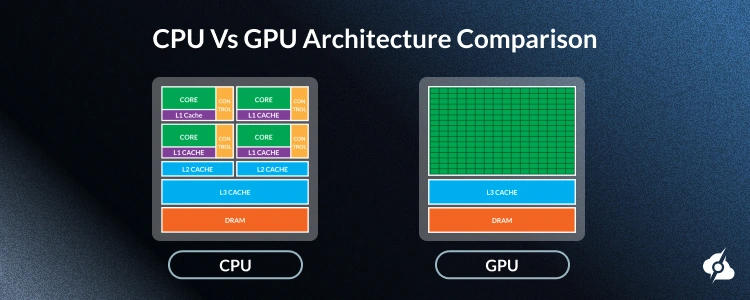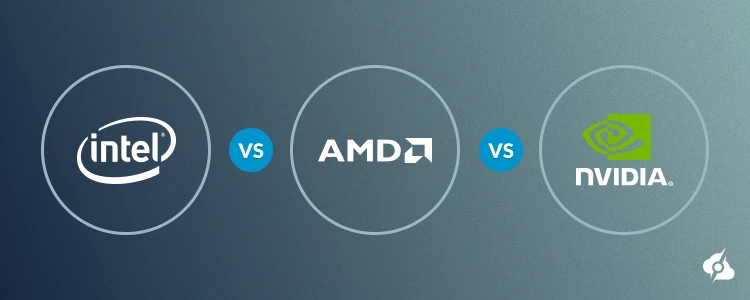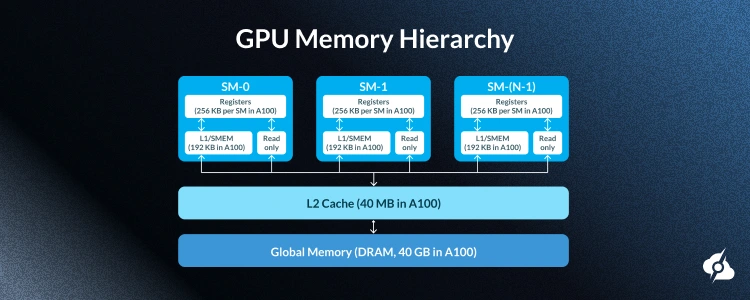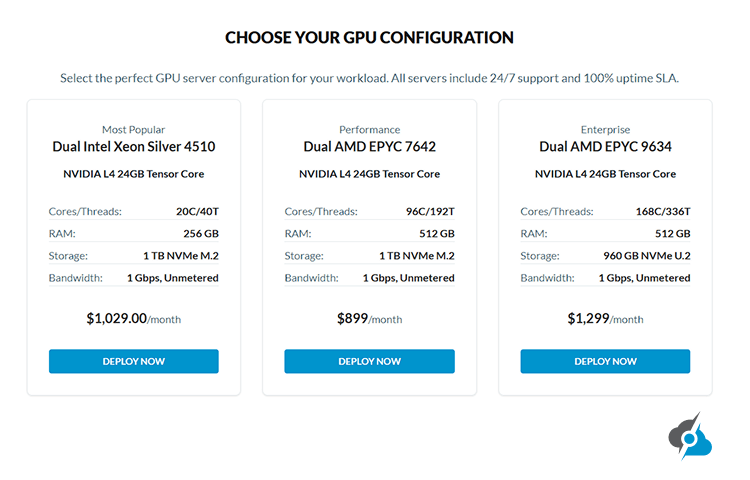GPU Architecture: How Graphics Processing Units Work

The GPU architecture is the design of a graphics processing unit, establishing the GPU’s ability to handle parallel processing, which is crucial in today’s high-performance computing. This entangles many real-world applications, from video rendering to gaming, machine learning, and AI.
While GPUs were originally crafted to handle video processing, covering mainly graphics rendering. Nowadays, their architecture aligns with modern demands such as facial recognition, AI model training, and machine learning, which goes beyond general-purpose computing and delivers ultimate reliability.
At ServerMania, we proudly deliver high-end GPU infrastructure covering GPU server hosting, AI server configurations, cloud GPU solutions, and top-notch dedicated servers. We support businesses with the most demanding intended applications, deep learning infrastructure, and machine learning workloads.
This in-depth guide breaks down the GPU architecture in both simple and technical terms, revealing how memory, cores, and threads simultaneously come together to drive the most advanced projects.
GPU Evolution: From Graphics Rendering to AI & ML Powerhouse
The GPU architecture is the core of a graphics processing unit, and the organization blueprint of the memory hierarchy, processing units, and execution order.
In contrast to CPU cores, which specialize in sequential execution, GPUs rely on parallel computing, running thousands of threads simultaneously. This means executing the same instruction over multiple data streams at once, which makes them perfect for high-performance computing, elevating GPUs beyond traditional video rendering.
The Leap in GPU Performance
To illustrate the rapid growth of GPUs over the years, we can take, for example, the first-generation “consumer GPUs” that were capable of executing about 100 million calculations per second. When we compare them to the 2025-era GPUs, capable of hitting more than 36 trillion, we notice around a 1,000x jump in performance for the last two decades.
This rapid growth is what expanded the GPU’s scope from a consumer-grade electronic (gaming/frame rendering) to enterprise-grade projects such as machine learning workloads, model training, many scientific analyses on large datasets, and crypto mining.
Modern GPUs perform 36 trillion calculations per second, computational power that once required entire supercomputers now fits in a single PCIe slot.
See Also: The Best GPUs for Mining in 2025
CPU vs GPU Architecture: Comparing Design, Cores, and Memory
Modern computing, whether it’s gaming and rendering or AI and machine learning, requires both CPU cores and GPU processing units.
While GPUs and CPUs work together to deliver the performance, their architecture is fundamentally different, and understanding what sets them apart is crucial for optimizing your server’s throughput.
Let’s start with their foundation…
Sequential (CPU) vs Parallel Processing (CPU)
The main difference between CPU and GPU architecture lies in how they perform the processing. CPUs work sequentially, which means that they require single or multiple threads simultaneously executing the complex logic. In contrast, GPUs specialize in parallel processing, utilizing thousands of CUDA cores to handle a single instruction across multiple thread blocks.
In short, the GPU’s ability to execute many threads at once is what makes the superior to CPUs in many modern workloads such as deep learning and model training.
Core Architecture Comparison
Another striking difference between GPUs and CPUs is in their core architecture. CPUs use a small number of powerful cores specializing in high performance, while GPUs offer anything from 1,000 to 10,000 simple cores, made for high throughput.
The CPU cores work at a higher clock speed, making their single-thread performance better, while the GPU cores stand out in parallel processing due to the sheer number of smaller cores. This makes CPUs better for certain practical applications, while GPUs are significantly more efficient at other workloads.
Memory Architecture Differences
The memory architecture is another area where GPUs are fundamentally different from CPUs. While CPUs require a large cache size and low-latency memory, GPUs benefit from high-bandwidth memory, shared memory, and global memory.
This is what maximizes GPU acceleration for parallel computing and makes them excellent for many modern workloads, whereas CPUs would struggle to keep up.
Here’s a quick, easy-to-scan architecture comparison:
| Aspect | CPU Architecture | GPU Architecture | Performance Difference |
|---|---|---|---|
| Core Count | 4-64 powerful cores | 1,000-10,000+ simple cores | 150x more cores |
| Clock Speed | 2-5 GHz | 1-2 GHz | CPU 2-3x faster |
| Cache Size | 20-75MB L3 | 4-6MB L2 | CPU 10x larger |
| Memory Bandwidth | 50-100 GB/s | 1,000-2,000 GB/s | GPU 20x higher |
| Power Efficiency | 10-20 GFLOPS/W | 50-100 GFLOPS/W | GPU 5x better |

Inside GPUs: Core GPU Architecture Components
Modern GPU architecture is a blend of specialized units, programming, and virtual components working together to achieve flawless parallel processing.
To understand better how everything works, let’s cover all architectural GPU components:
Graphics Processing Clusters (GPCs)
The surface-level building blocks of GPUs are the Graphics Processing Clusters (also known as GPCs). Modern NVIDIA GPUs, like NVIDIA L4 or NVIDIA H200, contain 4 or 8 GPCs (clusters), each of which is the core management unit for the streaming multiprocessors and memory controllers coordination.
In short, this is the birth of parallel processing.
Streaming Multiprocessors (SMs)
If we dig deeper, inside each GPC, you’ll find streaming multiprocessors (SMs), which are the actual processing components. Each of these SMs can contain 64, up to 128 CUDA cores, fully enabling warp scheduling of 32 threads per warp, with their own dedicated register files and shared memory usage.
CUDA Cores and Stream Processors
CUDA cores, or as AMD calls them (stream processors), are what perform the mathematics required by floating point calculations, rendering, and, of course, machine learning. The design of these cores is what allows so many threads to be executed simultaneously, widely known as “GPU acceleration“.
Tensor Cores and RT Cores
We also have “Tensor cores”, which are designed to accelerate matrix operations that are primarily used in deep learning and model training. On the other hand, there are also “RT cores”, which are meant to handle ray tracing, which is the responsiveness and quality of the lightning in games and simulations.
Memory Controllers and Interfaces
The memory controllers are the management and coordinate the access between global memory, shared memory, and high bandwidth memory (HBM). The memory handling is absolutely critical for a GPU, ensuring that the processing units can feed the cores efficiently in high-demand workloads.
Raster Operations Pipelines (ROPs)
Raster Operations Pipelines (ROPs) are responsible for the final stage of rendering, converting processed data into pixels on the screen. They manage blending, anti-aliasing, and writing to texture memory, optimizing the GPU performance in graphics-heavy applications.
Texture Processing Units (TPUs)
At last, we have the Texture Processing Units (TUPs), which are mostly required by 3D rendering for mapping and filtering of the textures. This is what makes GPUs so efficient in gaming, allowing them to render hundreds of frames per second without bottlenecks.
Texture Processing Units (TPUs) handle the mapping and filtering of textures in 3D rendering. By working in parallel with other units, they allow GPUs to efficiently process high-resolution images and graphics rendering workloads without bottlenecks.
💬 ServerMania GPU servers are equipped with NVIDIA L4 Tensor Core GPUs, leveraging the Ada Lovelace architecture to deliver exceptional performance for model training and machine learning.
NVIDIA, AMD, and Intel GPU Architectures: How They Compare
To grasp the concept of different GPU architecture designs and understand why GPUs have evolved in both consumer and enterprise points of view, we’ll compare the leaders in the market, NVIDIA vs AMD vs Intel GPU designs, helping us outline architecture-specific features.

NVIDIA Architecture Evolution
NVIDIA GPUs have gone through many different generations, named Kepler and Maxwell to Pascal, Turing, Ampere, Ada Lovelace, and now Hopper architectures. Each of these leaps in architectural designs has brought something new in regard to memory hierarchy, Tensor Core integration, and has improved on the old builds, bringing advancements in workloads.
For instance, the NVIDIA L4 Tensor Code GPU, from the Ada Lovelace generation, features 24GB GDDR6 memory, making it excellent for GPU acceleration.
This means both AI and ML, plus graphics rendering.
AMD RDNA and CDNA Architectures
When it comes to AMD GPUs, which utilize the RDNA for gaming and CDNA for AI and ML workloads, there are many architectural innovations, such as infinity cache and chiplet designs, which optimize modern demands for both general-purpose computing and enterprise-grade loads such as AI and ML.
Intel Arc and Xe Architecture
In turn, Intel Arc and Xe-HPG/GP GPUs deliver XMX Engines and Xe Matrix Extensions, specifically crafted for AI acceleration, seen in Intel graphics. While this technology is still new on the market, Intel aims to greatly improve parallel processing by providing still experimental, yet solid GPU performance.
Here’s a quick architecture comparison:
| Architecture | Process | CUDA/Stream Cores | Memory | TFLOPs | TDP | |
|---|---|---|---|---|---|---|
| NVIDIA L4 | Ada Lovelace | 4nm | 3,072 | 24GB GDDR6 | 36.0 | 75W |
| RX 7900 XTX | RDNA 3 | 5nm | 6,144 | 24GB GDDR6 | 61.4 | 355W |
| A770 | Xe-HPG | 6nm | 4,096 | 16GB GDDR6 | 19.7 | 225W |
| H100 | Hopper | 4nm | 16,896 | 80GB HBM3 | 67.0 | 700W |
Quick Summary:
Here are the standout improvements over the last decade from the leaders in the GPU market:
- NVIDIA: Tensor Cores, RT Cores, NVLink
- AMD: Infinity Cache and Chiplet Design
- Intel: XMX Engines, and Xe Matrix Extensions
See Also: AMD vs NVIDIA GPU Comparison
GPU Architecture in Practice: Industry-Specific Workloads
To understand how the GPU architecture drives most of today’s demanding workloads, we will review some of the most popular use cases. We will go through AI and ML deep learning, to cryptocurrency mining and real-time graphics rendering, concerning exactly how GPU cores outperform CPU cores.
After all, that’s everything that matters when it comes to GPU acceleration!
AI, ML & Neural Networks
GPUs have grown to be the most important piece of hardware equipment when it comes to workloads involved in model training and neural networks.
The thousands of CUDA cores and Tensor cores execute CUDA kernels, seamlessly processing single instruction multiple threads at once, dramatically reducing training times..
The GPU’s ability for single instruction multiple data handling is one of the greatest advantages when compared to CPUs for specific loads like machine learning, facial recognition, and neural networking.
Cryptocurrency Mining
The parallel processing capabilities of GPUs make them perfectly suited for cryptocurrency mining architectures. Multiple threads simultaneously perform the same cryptographic calculations across processing units, delivering high throughput and energy efficiency.
When compared to CPU cores, the GPUs specialize in floating point operations and repeated hashing, accelerating mining tasks and reducing electricity costs. ServerMania supports mining workloads with configurations that can include multiple GPUs in a single node, allowing full GPU performance utilization.
Ray Tracing and Graphics
Modern GPUs with RT cores excel in real-time ray tracing, providing realistic lighting and shadows in gaming and professional graphics.
Tasks like graphics rendering or computer-aided design see up to 2.5x performance improvement over CPUs. By combining shared memory and high bandwidth memory, GPUs ensure high frame throughput, low memory latency, and smooth visual output for demanding applications.
Here’s a quick GPU vs CPU use case performance comparison:
| CPU | GPU | Gain | |
|---|---|---|---|
| AI Training (Neural Networks) | Baseline | 10x faster | 10x |
| Cryptocurrency Mining | Baseline | 15x faster | 15x |
| Real-Time Ray Tracing & Graphics | Baseline | 2.5x faster | 2.5x |
| Video Encoding or Gaming | Baseline | 5x throughput increase | 5x |
💬 ServerMania Solutions: Our GPU hosting solutions support everything from AI research to blockchain validation, providing flexible options for parallel processing and GPU acceleration.
GPU Memory Hierarchy: From Registers to Global Memory
To grasp how GPU memory hierarchy works, we need to understand the GPU microarchitecture and learn more about how on-chip memory and global memory interact.

For a GPU server, regardless of whether running a single thread block or multiple tasks across thread blocks, it’s critical to manage memory layers, which enables engineers to optimize performance for next-generation workloads.
Let’s go through the most important aspects of memory hierarchy:
Register Memory
Registers are the fastest, lowest-latency memory available on a GPU, located on the chip. Each individual thread has access to its own registers, providing near-instant access for computations and minimizing interference from other threads.
Shared Memory and L1 Cache
Shared memory and L1 cache reside on the chip and are shared among threads within a thread block. They allow multiple threads to communicate efficiently and reduce reliance on slower global memory, which helps optimize performance for complex GPU technology tasks.
L2 Cache Architecture
The L2 cache is larger and sits between on-chip memory and global memory, providing a buffer to store frequently used data. It helps with the data coordination across multiple thread blocks and maintains peak performance across multiple tasks.
Global Memory (GDDR6/HBM)
Global memory is off-chip but essential for storing large datasets in next-generation GPUs. While it has higher latency than local memory, proper use of thread blocks and caching strategies can significantly reduce delays for individual threads.
Constant and Texture Memory
Constant memory is read-only for all threads and optimized for broadcast scenarios, while texture memory accelerates graphics and compute workloads with spatial locality. Both reduce pressure on memory and help optimize performance across multiple workloads.
Memory Bandwidth and Latency
Memory bandwidth and latency directly affect how quickly individual threads and other threads can access data. Balancing on-chip memory, shared memory, and global memory is key to achieving peak performance in GPU microarchitecture designs compared to previous microarchitectures.
The following table outlines the sizes, bandwidths, latencies, and scope of the main GPU memory types, helping visualize how local memory, on-chip memory, and global memory interact across single thread block and multiple thread block scenarios.
| Size | Bandwidth | Latency | Scope | |
|---|---|---|---|---|
| Registers | 256KB/SM | 8TB/s | 1 cycle | Thread |
| Shared/L1 | 128KB/SM | 4TB/s | 20 cycles | Block |
| L2 Cache | 6-40MB | 3TB/s | 200 cycles | Device |
| Global (HBM2e) | 40-80GB | 2TB/s | 400 cycles | Device |
GPU Server Infrastructure: Requirements & Deployment
Deploying a GPU server efficiently not only requires careful planning but also thoughtful consideration of your workload intent. So, whether you’re about to deploy a server for graphics rendering, multiplayer hosting, model training, or other high-performance computing, we recommend evaluating your task.
Here’s the stream of considerations before deployment:
Power and Cooling Requirements
Some of the most capable GPU servers require a lot of power, and a bad power supply or weak cooling can significantly reduce your GPU throughput. That’s why one of the most important considerations before deployment would be to consider sufficient power supply capacity (at least 2 x GPU TDP) and a cooling system that can keep the ambient temperature below 25°C.
Here at ServerMania, we provide all of this through our Tier 4 Data Centers, and even if you want to own your configuration instead of renting, our Colocation and Managed Services might suit you best.
See Also: GPU Thermal Management
PCIe Configuration and Bandwidth
Another consideration that ML engineers and DevOps teams need to account for is the PCI interface, which determines how quickly data is transferred. We refer to moving data between the GPU memory, CPU cores, and storage, and configurations like PCIe 4.0 x16 or PCIe 5.0 x16 offer sufficient memory bandwidth for GPU acceleration in tasks.
Virtualization and GPU Partitioning
Virtualization allows multiple users or containers to share GPU resources, enabling efficient parallel processing across workloads. GPU partitioning divides CUDA cores, Tensor cores, and memory into isolated segments, ensuring each virtual machine or container maintains consistent GPU performance.
This is particularly important for cloud GPU solutions and multi-tenant environments!
Here’s an easy-to-scan GPU Tiers and their respective requirements:
| Power Draw | Cooling Needed | PCIe Gen | Bandwidth Required | |
|---|---|---|---|---|
| Data Center (L4) | 75W | Standard/Enhanced | PCIe 4.0 x16 | 40 Gbps |
| Entry (RTX 4060) | 115W | Standard | PCIe 4.0 x8 | 10 Gbps |
| Mid (RTX 4070 Ti) | 285W | Enhanced | PCIe 4.0 x16 | 25 Gbps |
| High (RTX 4090) | 450W | Liquid/Advanced | PCIe 4.0 x16 | 50 Gbps |
| Data Center (H100) | 700W | Liquid Required | PCIe 5.0 x16 | 100 Gbps |
Cloud vs. On-Premise GPU?
Choosing between cloud GPU solutions and on-premise deployments depends on workload scale, budget, and flexibility requirements.
The cloud infrastructure allows rapid scaling and access to high-performance GPUs without upfront investment, while on-premise deployments provide maximum control over power, cooling, and PCIe configurations. So, based on your workload and futuristic intent, we strongly advise choosing wisely.
Explore: ServerMania Dedicated Servers Vs. ServerMania IaaS AraCloud
Multi-GPU Configurations?
Whether in the cloud or on-premise, multi-GPU setups (using SLI, NVLink, or PCIe interconnects) can dramatically increase processing power. Hence, proper planning ensures each GPU receives adequate power, cooling, and memory bandwidth, maximizing efficiency for AI workloads, deep learning, or ML.
Here’s a quick checklist before deployment:
- Power supply capacity (2× GPU TDP recommended)
- Cooling solution (ambient temp <25°C)
- PCIe slot availability and generation
- Driver compatibility verification
- Network bandwidth for distributed training
- Storage I/O for data pipeline
Deploy a GPU Server with ServerMania
ServerMania provides enterprise-grade GPU infrastructure designed to meet the demands of AI model training, high-performance computing, and parallel processing.
Whether you need a single NVIDIA L4 Tensor Core GPU or a multi-GPU cluster, our solutions ensure high throughput, reduced latency, and reliable performance.
- Dedicated GPU Servers: Access powerful NVIDIA L4 Tensor Core GPUs for the most demanding workloads in the industry of AI, ML, Crypto Mining, and more.
- Flexible Configurations: Scale from single to multi-GPU setups tailored to your needs without the need for manual or on-site intervention through our managed services.
- Up to 100Gbps Connectivity: Guarantee the reduced latency for your GPU server workloads with our high-speed access for distributed training.
- 24/7 Expert Support: Ask us for help anytime and benefit from our dedicated guidance for GPU deployments, troubleshooting, migration, and optimization.
- Cooling Solutions: Maintain an optimal performance for high-density GPU clusters by taking advantage of our top-tier data centers
Configuration Options:
- Most Popular: Dual Intel Xeon Silver 4510 + NVIDIA L4 24GB Tensor Core, 20C/40T, 256GB RAM, 1TB NVMe M.2, 1 Gbps unmetered, $1,029/mo.
- Performance: Dual AMD EPYC 7642 + NVIDIA L4 24GB Tensor Core, 96C/192T, 512GB RAM, 1TB NVMe M.2, $899/mo.
- Enterprise: Dual AMD EPYC 9634 + NVIDIA L4 24GB Tensor Core, 168C/336T, 512GB RAM, 960GB NVMe U.2, $1,299/mo.

💬 Contact ServerMania today, get a free consultation, and deploy your GPU server to accelerate your AI and ML workload. We’re available for discussion right now!
Was this page helpful?

